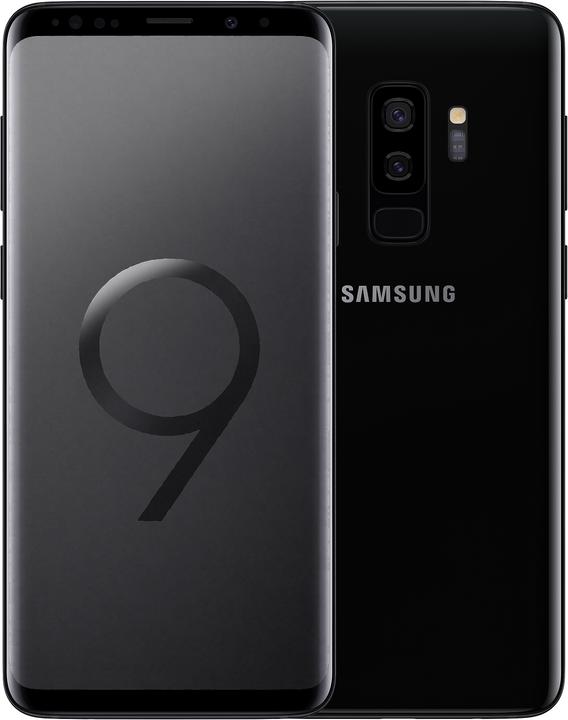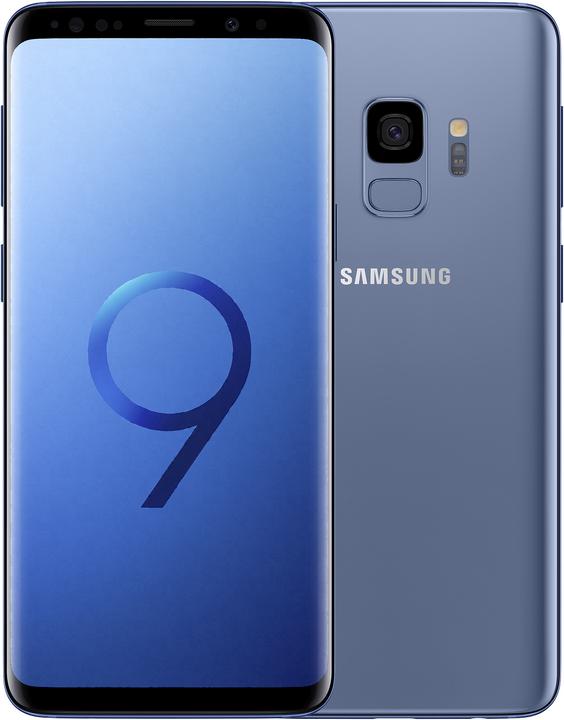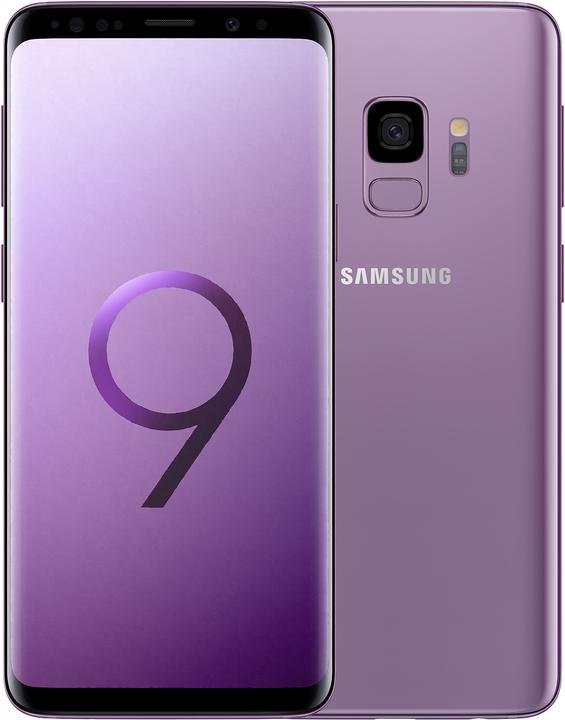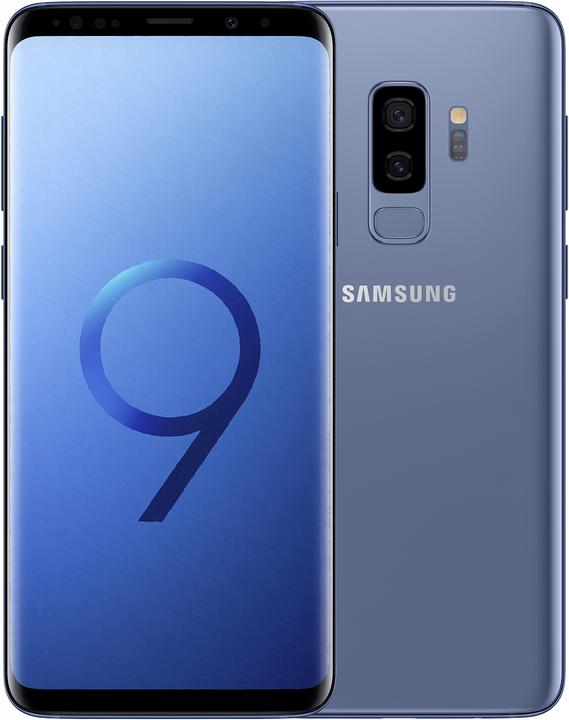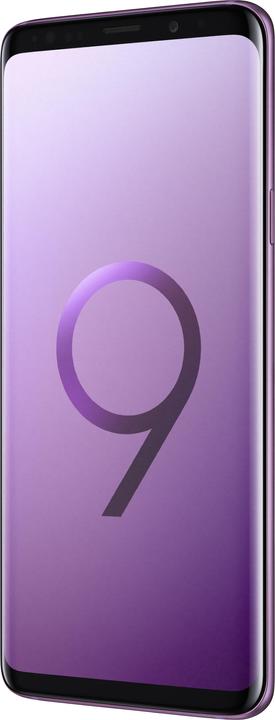
Samsung Galaxy S9: hardly revolutionary but still damn good
The Samsung Galaxy S9 is supposed to revolutionise cameras forever. Well, everything is supposed to be improved, at least. We put the S9 and S9+ to the test to see how they fared. And in the process we discovered more weak points than we bargained for.
By all accounts, the Samsung Galaxy S9 and its older brother, the S9+, are creating a stir on the market. They’re supposed to be better, faster and deliver more camera. There was no question of us not testing it. If you pre-ordered the phone, you’ll already have it in your sweaty palm. Otherwise, you can grab it now in our shop.
Video producer Stephanie Tresch and I have been carrying the thing around in our pocket for the last two weeks and testing it to within an inch of its life. While Stephanie was putting the S9 through its paces, I was pushing the S9+ to its limits.

The camera aka, the elephant in the room
The day we got our phones, we trudged out into the forest after work. Why? Because Samsung claims to deliver the best low-light photos of all time. Yip, on a smartphone camera. We couldn’t resist trying it for ourselves. But before you get too excited, let me warn you the tests aren’t finished yet, as the pro mode on the camera leaves a lot to be desired. We’ve still only managed to try out the auto mode in the dark.

A Zurich forest in the dark
The results are somewhat mixed. If it’s snapshots for the likes of Instagram you’re after, the quality is more than good enough. But we’re still waiting on this revolutionary single-lens reflex camera and system camera killer. Given Samsung has been marketing it as «The Camera. Reimagined.», you’d think the revolution was already here. The photos look quite good on the screen, but as soon as you set the zoom to 100 per cent, you see the workings behind it all.

Image section
You can see jagged edges on the roof of the house. That’s not necessarily the fault of the lens; it could be the sensor or software that’s behind it. Bear in mind: the DRAM in the camera system analyses and enhances every picture when you shoot in auto mode.

The trees on the hill are hit even harder
It seems as though the camera software uses an intelligent soft focus filter to edit image noise – something you notice on a lot of phones when you’re shooting in the dark. That’s what causes these jagged edges and rough lines. However, the camera doesn’t manage to eliminate the noise entirely. In the picture above, you can still see a lot of interference in the sky.
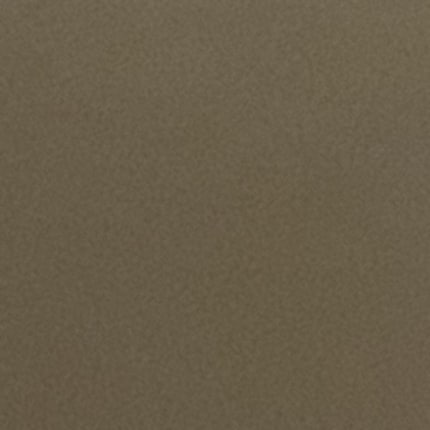
A piece of the sky
Right, so far so good. But my fellow tester and I were both taken aback. Surely the camera can do more? The f/1.5 f stop gives you the impression the picture above isn’t all it’s hyped up to be. That’s all well and good but the f-stop also isn’t the saviour for photography when it comes to low light performance. It is, however, an indicator that the camera must be capable of more. Especially as the pro mode lets you adjust a lot of settings.
The pro mode of dreams
The pro mode is a camera nerd’s best friend. There’s hardly any other smartphone camera with such a large variety of settings at your fingertips. A lot of manufacturers could do a lot worse than take a leaf out of Samsung’s book.
Let me give you an example. You can set the colour temperature manually in Kelvin (K). Smartphone cameras like to take shots where the colour temperature is a bit too warm. It’s probably partly because it stops people looking as white as a ghost. You usually run a real risk of that with big cameras. However, if you have your sights set on slightly more ambitious photography, the temperature of an image is important.
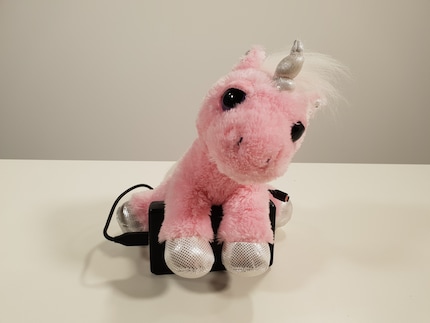
A shot of our editorial mascot taken with standard settings
Colour temperatures over 5000 K are considered warm. The light source determines the Kelvin value and settings. If I’d lit the area with a candle, the mascot would have turned orange at 2300 K. In other words, the purpose of the colour temperature settings isn’t to achieve a colour value; instead, it’s there to correct it. As soon as the light changes, from studio light to daylight, for instance, photos with the same colour temperature can take on different hues.
If you want to avoid a deathly pallor straight from taking the phone out the box, you’re better off with standard settings with lower Kelvin values.
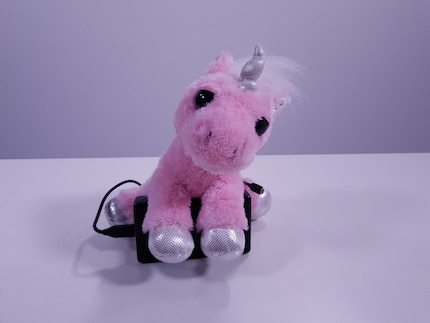
Our mascot with a flatter, cooler colour profile
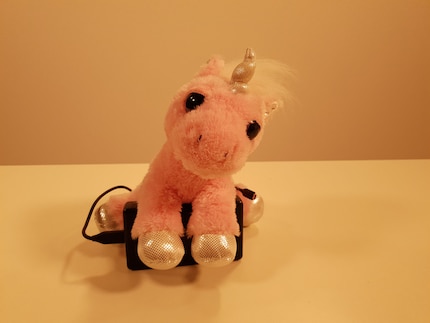
Unicorn mascot with 10000 K
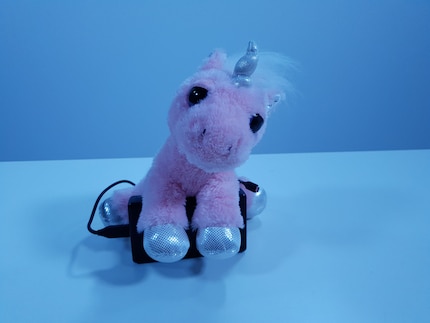
The mascot with 2300 K
In the S9 pro mode, you can drop the Kelvin to as little as 2300 K, which makes the image look very blue in daylight. If you go up to 10000 K, the photo looks orange. But on the S9 display, you’ll see an orange tinge on the selection bar at low temperatures; at high temperatures, the bar will display in blue. In other words, it’s the opposite of how the image appears.
While we’re on the topic of settings bars… The area where the phone accepts your finger command – known as the slider – is set up in a rather unique way. If your finger doesn’t quite reach the Kelvin slider or ISO slider, for example, it can be a good idea to switch from the pro mode. It’s frustrating, but you can correct it with a Samsung software update.
That’s just a long way of me saying the slider section is too small. If your fingers keep missing the slider section for the Kelvin controller – in blue below – you’ll end up in the camera mode selector – shown below in red. As you need to adjust the Kelvin section with a swiping motion, you end up swiping on the side if you miss the bit related to Kelvin settings.
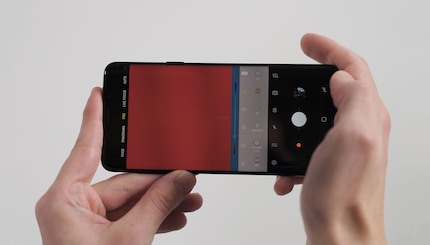
More or less what the controls look like today
There is a software update that realigns the control area. This lets you enlarge the Kelvin settings area and make the mode area smaller.
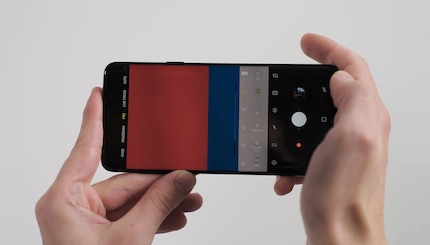
Improved look for the settings area
To cut a long story short: we still have to test the camera further and try to get low light to work better. Once we’ve done that, we can tell you what settings we used. That’ll be handy, as you can save up to two presets directly to your camera.
Before we broach the next topic, here’s a quick side note about cameras. If you want to use an artificial bokeh effect, you’ll need to get your hands on an S9+. That’s because the effect requires a second camera, which the small S9 doesn’t possess. What’s more, the S9’s camera software doesn’t allow you to create the effect virtually.
The image on the screen
As far as shape is concerned, the S9 doesn’t differ dramatically from the S8 – at first glance, at least. But as soon as you’ve got the S9 in your hand, you notice the defined edges on the sides of the phone. If they still feel a bit rubbery, it’s probably because the protective film is still on. The ninth series comes with foil you can peel off on the back and front as well as the sides.
But even without protective foil, the edges are smooth and distinct. That makes the 200 gramme smartphone non-slip and adds some character. No other phone feels like the S9. Nice one.
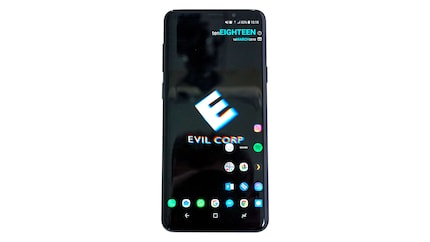
The infinity display, which is almost bezel-free at the sides, is slightly bigger, just as the phone itself is larger. Given this trend for large phones, it’s obvious that being able to use a phone with one hand has slipped down manufacturers’ priority lists over time. With my paws on the S9+, I can just get my thumb to reach the other side of the display. Stephanie with her dainty little fingers, on the other hand, has no chance. But the thing is, they haven’t increased the size of the phone proportionally to the screen. In other words, the edges and top and bottom of the phone have got smaller.
Probably the biggest change in terms of hardware is positioning the fingerprint scanner. In the S8, it was next to the camera. This meant you’d be forever smudging the camera before you got to the sensor. Then the next time you’d take a photo, a message would pop up telling you the lens was dirty. Oh come on. Not again. Really? But why?
Now the fingerprint sensor is under the camera system, where it should be. You might still find you accidently smear your fingers over the camera, but you won’t get that warning any more. Thanks, Samsung.
Let’s move on to the screen. Oh my goodness. How I’ve missed the AMOLED technology infinity display. I’m being serious. It hadn’t occurred to me before how much it made a difference. The image on the S9 is slightly sharper and more defined than the quality you get on the S8.
The phone’s big stumbling block
So far everything sounds rosy. But there is, in fact, a snag: the battery. The S9 battery capacity is 3000 mAh, while the larger S9+ features 3500 mAh. Samsung does claim this almost laughably large capacity is enough to make the phone last quite comfortably for a whole day at work, but we can’t confirm that.
After an average day of intensive use – listening to music, reading the news in the morning, WhatsApping and phoning in between times and using all kinds of social media channels in the evening – the S9+ maybe has about 10 per cent battery left. As the night draws on, there’s the risk the battery could completely die on you.
In terms of my own experience, I’ve already gone through five to seven per cent of my battery 30 minutes after I’ve got up and left the house. In the mornings, I listen to news programmes while I’m in the shower.
But usage affects the S9 even more. The little battery won’t last you a full day with normal to excessive use. When Stephanie was testing out the S9, the battery ran out several times. Essentially the smartphone was just a paperweight worth a thousand Swiss francs.
The battery life issue might be down to the fact the current generation of phones runs on new Exynos chips. The Exynos 9810 system on a chip claims to be energy efficient, which may be the case but the software guzzles too much battery. That or the battery is just too small.
I assume future sales of the Galaxy phone will come with the new Snapdragon 845. Only time will tell if these versions are more energy efficient.
Alternatively, you can achieve a lot with software optimisation. Samsung is known for drastically modifying the Android version on their phones. Sceptics think that boils down to Samsung not liking Google. If the battery problem was caused by the software, less modification options would have been better. All the same, the Samsung sidebar is nice. After a bit of quick configuration, you can reach your most used contacts with a touch of the screen.
Until then, keep a powerbank on you or charge your mobile at the office. It shouldn’t have to be like this, but that’s the reality of the S9 at the moment.
Maybe it’s a bit too clever
The S9 series works well straight out of the box. Maybe there’s such thing as it working too well? Obviously, the factory builds the system so it always works at an optimal level. Every second you’re using the phone, it has to deliver the best performance and make tweaks here and there. That’s most apparent with the sound, whether you’re listening via the stereo speakers at the top or headphones at the bottom of the phone.
What you want is Dolby Atmos. The sound is much fuller, even if the audio files you’re playing don’t come with Atmos effects. So what’s the trick? The S9 series can actually simulate the Dolby Atmos sound by boosting basses and trebles as well as tuning them down. The phone does that on the fly as standard. In other words, when you’re listening to music, the S9 is always adjusting the sound in real time.
Tech-wise, this effect is impressive. In practice, however, it’s pretty superfluous.
Wondering how it works? You might be listening to a song and halfway through, the Atmos system scales the bass back and optimises the sound for vocals during a solo. Then the instruments come back in and the system boosts the bass a bit again. It also removes the vocal optimisation and insteads optimises the preset music.
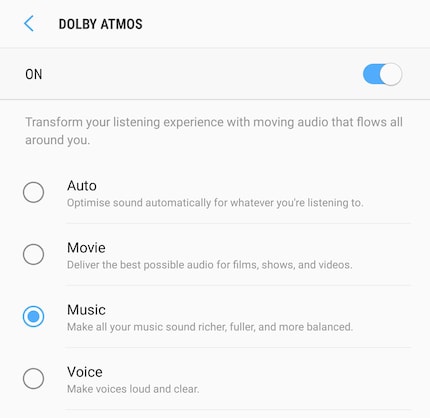
You have to adjust the Dolby Atmos settings otherwise your music will sound strange
If you don’t alter the Dolby settings, it’s so much harder to enjoy the music. That’s why I recommend going to the Dolby Atmos menu in Settings and selecting a suitable preset. I chose the «Music» option, as I mostly use the audio on the S9+ for listening to music.
You can also use video settings to instruct your phone to optimise images for video on an app basis by going to Settings → Search → Video Enhancer.
While we’re on the subject of image quality. You need to set the screen resolution to maximum by going to Settings → Display → Screen Resolution. Let’s face it, just because the screen can achieve high resolution doesn’t mean it automatically will.
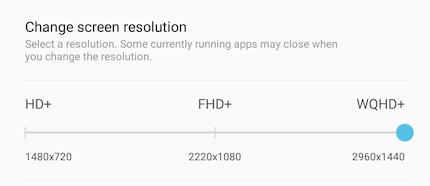
If you want full resolution, you have to set it manually
A few words about safety
Call quality via Wi-Fi calling has improved immeasurably. For a while now, you’ve been able to send smartphone phone signal to the receiver via Wi-Fi. That can be a real advantage in areas with poor network coverage and an open Wi-Fi router. It means you could even phone in a bunker… assuming there was Internet.
In the US, where the mobile communications network is still very limited in terms of call minutes and data volume, this can save you a tonne of cash. In Switzerland, on the other hand, most contracts have an unlimited plan. Here you’ll usually find it’s the upload and download speeds that determine the price.
But watch out: this system has to be used with care. Just because there’s an open Wi-Fi network around doesn’t mean you can or should trust it. As a general rule, when you’re phoning while you’re out and about using Wi-Fi calling, don’t exchange any confidential data. Setting up a rogue access point is easy to do.
Samsung has also given this security issue some consideration and recommended the phones be unlocked with intelligent scan as standard. The system seems to be a mash-up of iris scan and face unlock.


When you unlock the phone, the infrared scanner at the top of the phone switches on. A symbol then flashes on the top of screen, either showing an eye or the silhouette of a head. First you’ll see the eye symbol, which is probably looking for your iris. Whether you want to scan one eye or both of them is up to you. If your scan is accepted, the phone will unlock. If you’ve got on sunglasses or the light conditions are such the phone can’t read your iris, it will default to Face Unlock.
Exactly how that’s supposed to be safer than the normal Face Unlock on the S8, I’m not entirely sure. For the most part, it seems like Samsung wants to keep up with Apple’s face unlock system, which runs really smoothly. However, Samsung’s system comes with certain pitfalls. For instance, I can shove Stephanie’s S9 in front of her face when she has her eyes closed and the phone unlocks. Here are some other observations from our tests:
- The Samsung unlock system doesn’t work in a dark bedroom. You don’t need much light, but if you don’t have any LEDs or night lights in your room you can forget Face Unlock on the S9, just as you could on the S8.
- The system doesn’t have a problem with glasses.
- Sunglasses, on the other hand, are on a «meh, it depends» case-by-case basis
- Samsung Pay doesn’t work with Intelligent Scan. That gives me the sneaky suspicion Samsung doesn’t trust its own security system.
Verdict: it’s no revolution, but it’s still bloody good
From the very beginning, it was clear the Samsung Galaxy S9 wouldn’t revolutionise the smartphone market. What it does represent, though, is a respectable upgrade from the S8. It features better sound, image quality and improved camera.
By contrast, the S9+ can be considered a mini revolution for the phone market in the context of the current Samsung line-up. While you’ll already recognise the dual cam from the Note 8, the system has been improved on the Galaxy S9+. In fact, it already delivers better pictures than the Note 8.
On the whole, both phones do their job very well. In other words, they don’t level out at average or just good performance. The systems run smoothly, quickly and are rarely or never slow. The phones even maintain this characteristic in the battery department, as they manage to gobble it up with efficiency.
The question is now whether it’s worth upgrading from the S8 to the S9. Stephanie is probably the best placed to answer that question, as she completed this very upgrade for the purpose of the test. «I wouldn’t say it’s essential to upgrade. Granted, you’ll get a nicer screen, better sound and a better camera. But you’ll need to compromise a bit of stress in the evening when the battery runs out.»
Journalist. Author. Hacker. A storyteller searching for boundaries, secrets and taboos – putting the world to paper. Not because I can but because I can’t not.
